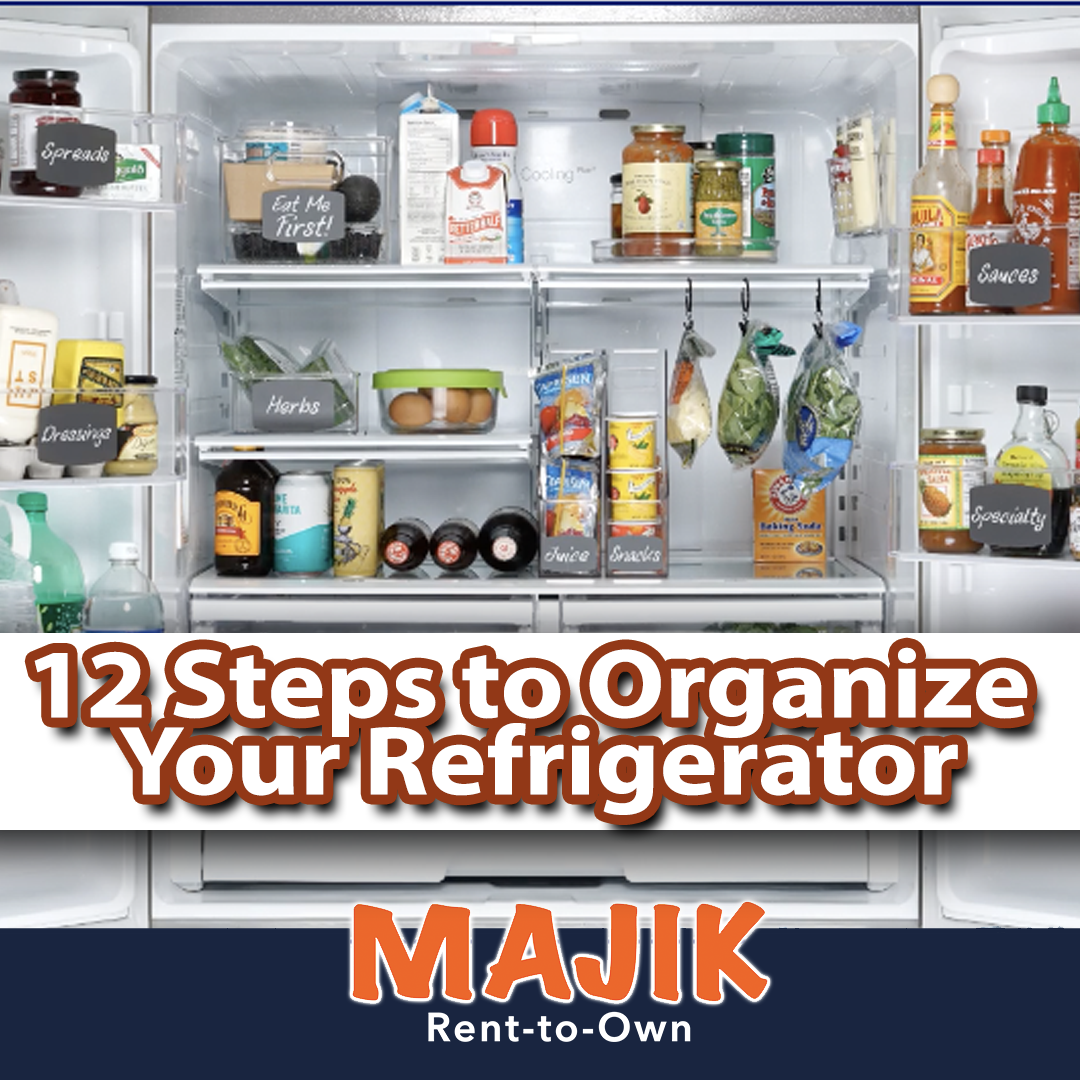
If you’re like most people, your refrigerator probably needs a good clean. The back of the fridge can become a haven for expired condiments, week old leftovers and molding vegetables if you’re not careful. This is why fridge organization is so important!
When you’re hungry, you don’t want to spend time hunting for the right ingredient. You want to reach inside the fridge and easily find the item you’re looking for. Having a “home” for every kind of food item can help keep things organized.
You will want to deep clean your fridge quarterly, about four times a year. And while every fridge is different, there are several hacks you can use to keep things in their place. Follow this step–by-step guide to have your fridge shining in no time!
What to Do Before Organizing Your Refrigerator
Before you go into full-on organization mode, you will want to clean and disinfect every surface on the inside of your fridge. This has more than just aesthetic benefits, as a sanitized fridge means less chance of foodborne illnesses and contamination. To easily disinfect your refrigerator, follow these steps:
· Empty the fridge entirely. Take everything out of the fridge so that you can easily wipe away dirt, stains or hardened spills. You can also work in sections if you’re worried about your food going bad. Another option is to put some ice in a cooler and temporarily place your perishable food items in there.
· Wipe down all surfaces. Take a disinfecting wipe or some paper towels and disinfecting spray and sanitize all surfaces of your fridge. This includes inside the door compartments and all shelf levels. Take the drawers out and let them soak in some hot, soapy water before wiping them down and putting them back in.
· Reassemble the fridge and add a deodorizer. Having a deodorizer in your fridge can help prevent unpleasant smells from lingering inside it. Baking soda acts as a great deodorizer. You can buy special fridge packs that stick the wall, but you can also just place an open container toward the back of the device.
How to Organize Your Refrigerator
Now that your refrigerator is spotless and sanitized you can begin making a game plan. It helps to mentally separate the fridge into sections and work through them one by one.
Different kinds of foods should be stored in the upper shelves, lower shelves, doors and drawers, so it’s important to organize accordingly. You can organize each section one by one, or choose the part of the fridge that interests you most.
Upper Shelf Hacks
Since your upper shelves are the highest point in your fridge, you will want to avoid storing raw meat or veggies up there. The best things to store on the top shelves are things like leftovers, drinks and ready-to-eat foods like yogurt, cheese and deli meats.
These foods usually have a shorter shelf life than condiments or oils and butters, so it’s helpful to keep them well marked and organized.
1. Make an “Eat Me First” Box for About-to-Expire Foods
Remember those boxes you bought? Label one of those “Eat Me First” and place anything inside it that is nearing its expiration date. If you’re unsure if an item has gone bad or not, it’s best to err on the side of caution. When you can, label all leftovers with the date that they were made and reference this chart from Foodsafety.gov to see how long they will last.
2. Use a Lazy Susan to Easily Find Food
The back of your fridge can become a black hole where food items get lost until long past their expiration date. Keep all food products easily accessible with a lazy Susan! Traditionally used in the spice cabinet, lazy Susans are useful in the fridge as well. Keep things like opened jars, snacks or condiments on top and spin the disk as needed to reach the item you need.
3. Hang Baskets to Utilize Wall Space
You can buy baskets that stick to the side of your fridge with suction cups. They are super handy for putting small things that might otherwise get lost in the refrigerator. For example, you can put string cheese, small cups of hummus or pre-made lunch meat and cheese rollups! Just stick the basket to the insides of your refrigerator wall.
Lower Shelf Hacks
Once the top shelf is in perfect order, you can move on to the lower shelves. Since they are below the ready-to-eat foods, it’s safe to house raw ingredients here. Things like packaged, raw meats that are part of an upcoming recipe can be carefully stored on the lowest shelf.
If there are extra ready-to-eat ingredients that won’t fit on the top shelf, you can store these in the lower shelves as long as they are above the meats. While storing meat is pretty self-explanatory, here are some hacks for those other lower-shelf items.
4. Group Like Items Together
Keep like items grouped together with clear baskets to ensure they are easily accessible and ready to grab. Baskets could contain leftovers, sandwich fixings, smoothie ingredients or sauces.
5. Use File Organizers to Store Snacks
Most paperwork is done digitally these days, making file boxes a thing of the past. However, theses boxes make the perfect shape to store all kinds of snacks. You can store anything from small containers of chopped veggies to yogurts, pouches of applesauce and pouch drinks. Label them for even better organization.
6. Use Curtain Ring Clips to Hang Bagged Items
Many fridges have wire shelves or bars on the edge of their shelves. If you have bagged items like shredded cheese or lettuce you can hang them from the edge of your shelves to use the space below! You will need to buy ringed curtain clips. Then simply clip the curtain ring clips on and then hang your rolled bags as needed.
Crisper Drawer Hacks
The crispers, also known as the drawers at the bottom of most fridges, are often humidity and temperature controlled to keep certain foods fresh longer. There is an art to storing your food properly in the crisper, as some foods need more humidity and some need less. These humidity controls are perfect for fruits and vegetable, just make sure you know what goes where.
7. Use Drawer Dividers
You can use dividers that are normally used for clothing drawers in your crisper drawers too! Just buy the adjustable kind and organize to your liking. It’s best to group greens like lettuce and spinach together, onions, garlic and ginger can go in another, and things like carrots and snap peas in another!
8. Line the Bottom With Paper Towels
Your crisper drawers can be some of the most unpleasant places to clean in your fridge. Keep them cleaner, longer by placing a layer of paper towels at the bottom of the drawers before loading them with fruits and veggies. The paper towels will collect little bits of broccoli or onion peels that tend to fall off over time. Replace them every two weeks to make cleaning a breeze.
9. Learn Your Humidity Controls
Like we mentioned earlier, knowing how to properly use your humidity settings on your crisper will help your fruits and veggies last longer. You can set the humidity from high to low on most fridges, so set one drawer to high humidity and one to low.
You should put anything that can rot in the low humidity drawer. This includes fruits and veggies that emit ethylene gas like apples, pears, avocados and most fruits. Ethylene gas emits from certain fruits (and some vegetables) and it causes many foods to ripen and expire faster. In the high humidity drawer you should put your leafy greens like spinach, arugula and herbs. The moisture keeps the veggies crisper and they’ll keep fresh longer.
Door Hacks
The refrigerator door is the warmest part of the fridge, so only condiments should go there. While many people do this, it’s not best practice to put eggs or milk in the door, as they should be placed in a colder part of the refrigerator.
Condiments, sauces, butter and other less-perishable items are perfect candidates for door storage, but that doesn’t mean it shouldn’t be orderly. Keep your refrigerator doors spick and span with these hacks.
10. Designate Each Door Section and Label It
To keep things supremely organized, keep like items together in each door divider and label the outside of the divider with a sticker or magnet. Examples of like items include: sauces (hot sauce, soy sauce, etc.), sandwich dressings (mayonnaise, mustard, relish, ketchup), or specialty items (olives, pesto, tapenade).
11. Use an Egg Carton to Store Condiments
Place an egg carton at the bottom of any section where you are storing condiments in bottles. Things like bottled mustard, mayo, ketchup or dressing can be stored upside down, nose first in the egg cartons. This will keep them organized and reduce waste because all of the liquid will be sitting near the opening of the bottle. Never shake or tap your condiments out of their containers again!
12. Fill One Lower Door Shelf with Kids Drinks
Create a kid-accessible “refuel zone” on the bottom shelf. Fill it with kid drinks or grab-and-go snacks like yogurt. Teach your kids that they can grab a drink whenever they are thirsty and keep it stocked for them.
If you clean your fridge regularly you will be surprised how much faster and easier cooking can be. Simple things like grabbing the ranch dressing or some baby carrots to snack on can be streamlined with these simple processes. Bonus points if you have kids, as they are sure to love the snack stations! Now just sit back, relax and enjoy the “fruits” of your labor.





